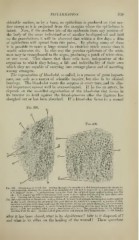Page 699 - My FlipBook
P. 699
1 ;
INFLAMMATION. 709
siderable surface, as by a burn, no epithelium is produced on that sur-
face except as it is projected from the margins \vhere the epithelium is
intact. Now, if the smallest bits of the epidermis from any portion of
the body of the same individual or of another be clipped off and laid
on the granulations, it will be observed that within a few days a film
of epithelium will spread from this point. By placing many of these
it is possible to cause a large wound to cicatrize much sooner than it
would otherwise do. In this way the peculiar epidermis of the white
man may be transplanted to the negro, producing a patch of white skin,
or vice versd. This shows that these cells have, independent of the
organism to which they belong, a life and individuality of their own
which they are capable of carrying into strange places and of asserting
among strangers.
The organization of blood-cfot, so called, is a process of great import-
ance, not only as a matter of scientific inquiry, but also in its clinical
bearings. The blood-clot meets the surgeon at every turn, and its clin-
ical importance cannot well be over-estimated. If he ties an artery, he
depends on the so-called organization of the blood-clot that forms in
its interior to hold against the blood-pressure after the ligature has
sloughed out or has been absorbed. If a blood-clot forms in a wound
Fig. 399.
Fig. 400.
MhhSk
Fig. 399.—Absorption of Blood-clot. Section through the margin of a clot formed among the tissues by
extravasation, showing the growth of granulations by which it is removed: o, n, portions of clot
b. b, original tissue; c, c, granulations springini: from the original tissue and projecting into the
clot; d, <1, wandering cells or leucocytes that seem to have taken red blood-discs into their inte-
rior. (Section cut in gum arable and stained with ha.'matoxylin X 350, Black.
;
Fig. 4U0.—Absorption of Blood-clot. Section through the margin of a blood-clot formed by extravasation
in the tissues, showing the growth of the granulations by which it is removed: a, poriion of clot,
showing fibrinous reticulum enclosing the blood-discs, which ;ire much shrunken, and occasional
wandering cells interspersed; h, newly-formed tissue projecting into the mass in the form of pro-
ces.ses. which are covered with young granulation-ceds, c. c. The granulations are in intimate
relation with the clot. (Section cut in gum arable and stained with hematoxylin X 350, Black.)
;
after it has been closed, what is its significance? how is it disposed of?
and what is its effect on the healing of the wound ? These questions
INFLAMMATION. 709
siderable surface, as by a burn, no epithelium is produced on that sur-
face except as it is projected from the margins \vhere the epithelium is
intact. Now, if the smallest bits of the epidermis from any portion of
the body of the same individual or of another be clipped off and laid
on the granulations, it will be observed that within a few days a film
of epithelium will spread from this point. By placing many of these
it is possible to cause a large wound to cicatrize much sooner than it
would otherwise do. In this way the peculiar epidermis of the white
man may be transplanted to the negro, producing a patch of white skin,
or vice versd. This shows that these cells have, independent of the
organism to which they belong, a life and individuality of their own
which they are capable of carrying into strange places and of asserting
among strangers.
The organization of blood-cfot, so called, is a process of great import-
ance, not only as a matter of scientific inquiry, but also in its clinical
bearings. The blood-clot meets the surgeon at every turn, and its clin-
ical importance cannot well be over-estimated. If he ties an artery, he
depends on the so-called organization of the blood-clot that forms in
its interior to hold against the blood-pressure after the ligature has
sloughed out or has been absorbed. If a blood-clot forms in a wound
Fig. 399.
Fig. 400.
MhhSk
Fig. 399.—Absorption of Blood-clot. Section through the margin of a clot formed among the tissues by
extravasation, showing the growth of granulations by which it is removed: o, n, portions of clot
b. b, original tissue; c, c, granulations springini: from the original tissue and projecting into the
clot; d, <1, wandering cells or leucocytes that seem to have taken red blood-discs into their inte-
rior. (Section cut in gum arable and stained with ha.'matoxylin X 350, Black.
;
Fig. 4U0.—Absorption of Blood-clot. Section through the margin of a blood-clot formed by extravasation
in the tissues, showing the growth of the granulations by which it is removed: a, poriion of clot,
showing fibrinous reticulum enclosing the blood-discs, which ;ire much shrunken, and occasional
wandering cells interspersed; h, newly-formed tissue projecting into the mass in the form of pro-
ces.ses. which are covered with young granulation-ceds, c. c. The granulations are in intimate
relation with the clot. (Section cut in gum arable and stained with hematoxylin X 350, Black.)
;
after it has been closed, what is its significance? how is it disposed of?
and what is its effect on the healing of the wound ? These questions


